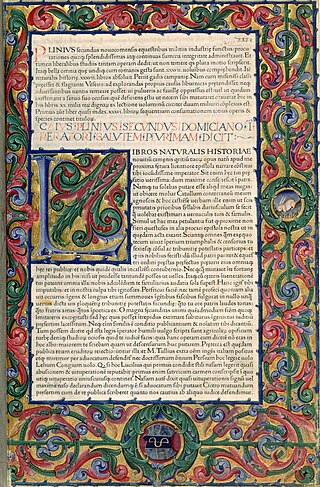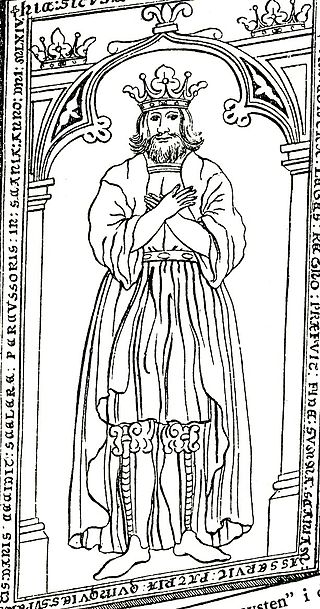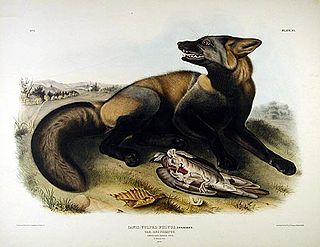Related Research Articles

Scandinavia is a subregion of Northern Europe, with strong historical, cultural, and linguistic ties between its constituent peoples. Scandinavia most commonly refers to Denmark, Norway, and Sweden. It can sometimes also refer to the Scandinavian Peninsula. In English usage, Scandinavia is sometimes used as a synonym for Nordic countries. Iceland and the Faroe Islands are sometimes included in Scandinavia for their ethnolinguistic relations with Sweden, Norway and Denmark. While Finland differs from other Nordic countries in this respect, some authors call it Scandinavian due to its economic and cultural similarities.

Gaius Plinius Secundus, called Pliny the Elder, was a Roman author, naturalist, natural philosopher, and naval and army commander of the early Roman Empire, and a friend of the emperor Vespasian. He wrote the encyclopedic Naturalis Historia, which became an editorial model for encyclopedias. He spent most of his spare time studying, writing, and investigating natural and geographic phenomena in the field.

The phoenix is an immortal bird that cyclically regenerates or is otherwise born again. While it is part of Greek mythology, it has analogs in many cultures such as Egyptian and Persian. Associated with the sun, a phoenix obtains new life by rising from the ashes of its predecessor. Some legends say it dies in a show of flames and combustion, others that it simply dies and decomposes before being born again. In the Motif-Index of Folk-Literature, a tool used by folklorists, the phoenix is classified as motif B32.

The Natural History is a Latin work by Pliny the Elder. The largest single work to have survived from the Roman Empire to the modern day, the Natural History compiles information gleaned from other ancient authors. Despite the work's title, its subject area is not limited to what is today understood by natural history; Pliny himself defines his scope as "the natural world, or life". It is encyclopedic in scope, but its structure is not like that of a modern encyclopedia. It is the only work by Pliny to have survived, and the last that he published. He published the first 10 books in AD 77, but had not made a final revision of the remainder at the time of his death during the AD 79 eruption of Vesuvius. The rest was published posthumously by Pliny's nephew, Pliny the Younger.

Scandza was described as a "great island" by Gothic-Byzantine historian Jordanes in his work Getica. The island was located in the Arctic regions of the sea that surrounded the world. The location is usually identified with Scandinavia.
Kvenland, known as Cwenland, Qwenland, Kænland, and similar terms in medieval sources, is an ancient name for an area in Fennoscandia and Scandinavia. Kvenland, in that or nearly that spelling, is known from an Old English account written in the 9th century, which used information provided by Norwegian adventurer and traveler Ohthere, and from Nordic sources, primarily Icelandic. A possible additional source was written in the modern-day area of Norway. All known Nordic sources date from the 12th and 13th centuries. Other possible references to Kvenland by other names and spellings are also discussed here.

The Fenni were an ancient people of northeastern Europe, first described by Cornelius Tacitus in Germania in AD 98.

Inge the Elder was a king of Sweden. In English literature he has also been called Ingold. While scant sources do not allow a full picture of his term of kingship, he is known to have led a turbulent but at length successful reign of more than two decades. He stands out as a devout Christian who founded the first abbey in Sweden and acted harshly against pagan practices. The kingdom was still an unstable realm based on alliances of noblemen, and Inge's main power base was in Västergötland and Östergötland; one of the earliest chronicles that mention his reign knows him as rex gautorum, king of the Geats.

Carta marina et descriptio septemtrionalium terrarum is the first map of the Nordic countries to give details and place names, created by Swedish ecclesiastic Olaus Magnus and initially published in 1539. Only two earlier maps of the Nordic countries are known, those of Jacob Ziegler and Claudius Clavus.
Olaus Magnus was a Swedish writer, cartographer, and Catholic clergyman.

The Hilleviones were a Germanic people occupying an island called Scatinavia in the 1st century AD, according to the Roman geographer Pliny the Elder in Naturalis Historia, written circa 77 AD. Pliny's Scatinavia is generally believed to have referred to the Scandinavian peninsula, which in the 1st century AD had not yet been fully explored by the Romans and was therefore described as an island. Pliny wrote that it was an island "of a magnitude as yet unascertained". The Hilleviones lived in the only part of the island that was known, and according to Pliny, they thought of their 500 villages as a separate (alterum) world.
The Calucones were a Gallic or Rhaetian tribe dwelling around present-day Chur during the Roman period.

The Madagascar serpent eagle is a species of bird of prey in the family Accipitridae. It is placed in the monotypic genus Eutriorchis. It is endemic to Madagascar. Its natural habitat is subtropical or tropical moist lowland forests. It is threatened by habitat loss.
Finningia is an old Latin name for Finland, along with Fennia, Finnia and most often used Finlandia. The name first appears in the work of Olaus Magnus from 1539, who placed Finningia olim regnum on the Scandinavian map to indicate the unhistorical past kingdom of Finland. The name presumably is a misconception of Pliny the Elder's Aeningia that probably did not mean Finland but the area of the present-day Baltic States. Aeningia seems to have first been confused with Finland by Jacob Ziegler in 1532.
Hippopodes, meaning "horse-footed," is an allegorical creature in Greek mythology that is often associated with greed. According to the myth, the Hippopodes were a tribe of beings with the lower bodies of horses and the upper bodies of men. They were said to have guarded a fabulous treasure, but their insatiable greed made them unwilling to share it with anyone. This greed ultimately led to their downfall. The allegory of the Hippopodes serves as a cautionary tale against the dangers of greed and avarice.

The kraken is a legendary sea monster of enormous size, etymologically akin to a squid or octopus, said to appear in the sea between Norway and Iceland. It is believed the legend of the Kraken may have originated from sightings of giant squid, which may grow to 12–15 m in length.

The cross fox is a partially melanistic colour variant of the red fox which has a long dark stripe running down its back, intersecting another stripe to form a cross over the shoulders. It tends to be more abundant in northern regions of Canada, and is rarer than the common red form, but is more common than the even darker silver fox.

A kronkåsa is a form of elaborate drinking cup that was used during the Renaissance in Sweden. Due the decoration, cups of this type are known as kronkåsor which means “crown cups”.
The Sogionti or Sogiontii were a Gallic tribe dwelling around present-day Sisteron during the Iron Age.
References
- ↑ Pliny the Elder, Natural History, iv.(13)96.
- ↑ 28 (Geografiens och de geografiska upptäckternas historia)
- ↑ Olaus Magnus' map of Scandinavia Archived 2009-06-01 at the Wayback Machine . See section F.
- ↑ Jacob Ziegler's map of Scandinavia Archived 2008-06-15 at the Wayback Machine .